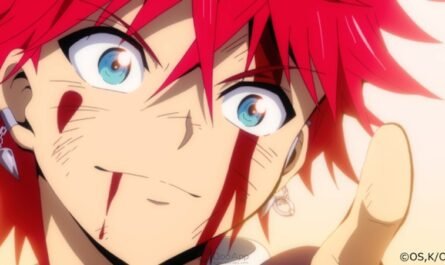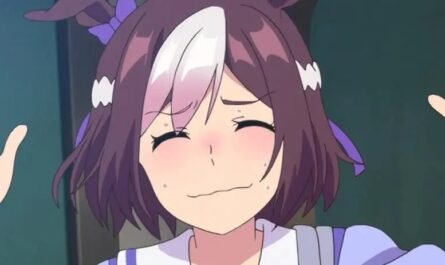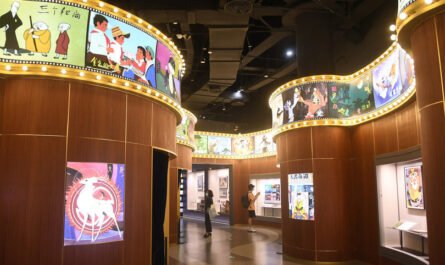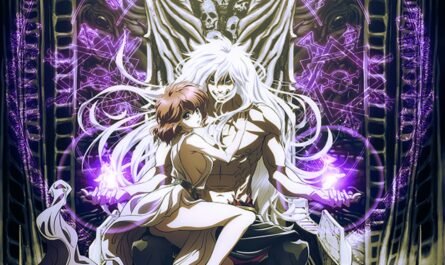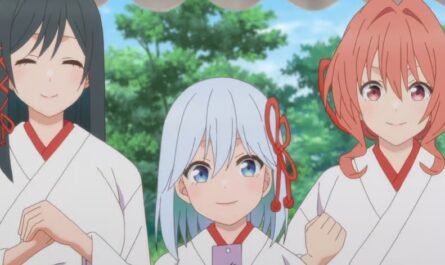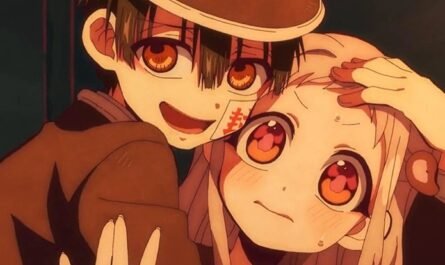“Nintama Rantaro the Movie: Dokutake Ninja Corps Strongest Strategist” is currently in theaters. On February 6, 2025, the second staff talk was held as a post-release event, with director Fujimori Masaya and character designer Niiyama Emiko on stage. In this article, we will introduce the event, which revealed their commitment to the animation of the action scenes and the precious shots that appear instantly.
This report contains spoilers. At the event, an illustration of the sixth graders that Niyama had drawn especially for the event was projected on the screen, and Director Fujimori and Niyama, holding puppets of Nanamatsu Kohei, appeared on stage to a warm round of applause. Director Fujimori was the original character designer for the TV anime Nintama Rantaro, and Niyama continues to play the role, taking over the character design role.
The two, who could be described as having a master-disciple relationship, began their friendly conversation by discussing the heads of the characters. Looking at the actual character design materials, Director Fujimori explained that the heads of the characters other than the first graders were made taller than in the TV anime, saying, “In action scenes, it’s easier to make the silhouettes stand out, and I think it was good that they looked dignified when the camera was placed low, even when they were sitting down.” Niyama also said, “When you try to draw them cool, the heads end up getting longer,” revealing that the heads of the characters, especially in action scenes, are longer than in the design. As a by-product of lengthening the proportions of all the students except the first-years, Director Fujimori said, “In comparison, the students in Class Ha become smaller (compared to the teachers), so they look cuter.
In the TV version, they are taller than the teachers’ chests.” Niyama also praised Director Fujimori’s storyboards, saying, “I wonder if Mr. Doi grew taller or if Kirimaru shrank… Kiri-chan is cute. I strongly agreed with the director that she had to be drawn cute because she was already this cute from the storyboard (drawn by the director).” The first half of the staff talk was about the attention to detail in the action scenes. The first thing brought up was the attention to detail in the action scene between Mr. Doi and Sonamon Moroizumi at the beginning. The director said, “In this movie, I wanted to make the way Mr. Doi and Amagi use ninja tools the same. The attendance book is always the same, but I think I gave instructions to throw the chalk in six frames, three pieces of chalk.” Niyama also said he was particular about this scene, saying, “Since Doi-sensei is fighting with the attendance book, it becomes worn out. Since we had to connect it from a beautiful state to that state, we were particular about the animation, and we gradually increased the number of scratches on the attendance book to match the action. The animation directors were divided into the first and second halves of the scene, and I was in charge of the first half. Still, the number of scratches on the attendance book had to match, so I did all of the attendance book (including the second half of the scene). If the density of the scratches increases or decreases, it would be unpleasant for the movie, so I was particular about it.” Director Fujimori commented, “I had no idea about the difficulties, and I watched it thinking it was well done.” Next, we discussed the action scene between Tenki and the sixth graders.
Regarding this scene, Director Fujimori said, “I wanted to make it a sortie like a hero story. I also wanted to divide the group into those good at close combat and those good at fighting from a distance and move the whole group, so I did it.” He also revealed, “In the TV series, it’s a comedy anime, so it’s correct to go with “Iketon” or “Gingin,” but of course, they are sixth graders, so they are capable. In this work, I portrayed them as having a calm and excellent side.” He also talked about the wounds of the sixth graders, which was a hot topic as a scene unusual for “Nintama.” Niyama laughed, saying, “When I was writing the setting, I was only worried about whether the shape of the blood would look like the shape of the prefecture.” I said that he had difficulty drawing Zenpouji Isaku, whose scars increase with each cut and whose silhouette changes. Furthermore, Director Fujimori also revealed the behind-the-scenes story of how he decided on the current color, considering the broad age range of the audience, saying, “At first, I considered a more vivid color…” Regarding the action scene featuring Yamada-sensei and graduates Sakuragi Seiemon and Wakaoji Kanbei, Director Fujimori said, “The storyboard was by Murano (Yuta), and the animation was by Horiuchi (Hiroyuki).
This scene was done by a person different from the action animation director Sekine (Masayuki). Horiuchi is a theorist who can draw weighty movements, and he worked on not only this scene but also the middle part of the action scene between Amagi and the sixth year. Sekine and Horiuchi draw different types of action, so it will be interesting to compare them and see the differences in the personalities of these two top-class actors.
Furthermore, regarding the fight between Yamada Rikichi and Zado Konnamon, one of the highlights in the second half, he said, “Sekine-kun was in charge of this action scene alone, but I wanted to show that Zado’s amazingness is on another level, so I asked him to do something out of the ordinary, like spinning in the air. When a normal human jumps, they can’t change their trajectory until they land, but Zado shifts the axis of his torso while spinning with the, so I asked him to draw it. Sekine-kun may not have understood what I was saying, but he drew it properly. I was impressed that he could draw it with such a request.” He revealed the behind-the-scenes of Zado’s superhuman action.
The talk then moved to a corner where Director Fujimori and Niyama shared their favorite parts of each other’s work. First, Director Fujimori introduced Niyama’s favorite drawings. There are about 770 cuts in Niyama’s work in this film, and Director Fujimori introduced four cuts that he particularly liked.
The first is the expression of Doi sensei as he leaves the Ninjutsu Academy. “This time, I changed the head and body proportions and made Doi sensei’s face a little neater. I was a little worried that they would say, ‘This isn’t Doi sensei,’ at the beginning of the movie, but I was grateful that Doi sensei was the usual gentle sensei,” he said, explaining why he chose this cut. Niyama was careful not to portray it as a final farewell (because he knew how the story would unfold). Niyama said, “I think it’s a very gentle expression with just the right balance.”
The second cut is the “sad face” that Shioe Bunjiro showed when searching for Doi sensei. “I like the expression, ‘I don’t want to say it either.’ The theme was to use the characters’ facial expressions properly, so I’m delighted with this cut. It is 100 points perfect.” “I spent about two days thinking about this scene, but the storyboards conveyed the importance of facial expressions, so I was able to draw each character’s emotions with care,” Niyama said, looking back on that time.
The third scene is of the sixth graders surrounding Kirimaru, with Tachibana Senzo’s “sad expression” being the focus of attention. “This is what I like about it. The sad expression you don’t usually see is good,” Niyama commented. Niyama replied, “The animation director here is Taniguchi (Akiko), and in the notes, she wrote, ‘I want to keep this scene as it is in the storyboard!’ So, I thought the same and drew this scene. Fujimori’s storyboard was good.”
The fourth scene is of the kind expressions of Yamada-sensei and the principal as they confront Kirimaru, who is depressed by Doi-sensei’s absence. The director said, “Kirimaru isHe is so depressed, but we don’t show Kirimaru, and we express it through their perspectives. Mr. Yamada’s expression when he talks is great,” he said. Niyama said, “When I read the storyboard, Kirimaru was shown for the first time, and then he never appeared again. So I had to make the viewer imagine that (Kirimaru looking depressed). To convey how much I care about Kirimaru, I included a fatherly smile that gives him a sense of security.” Niyama then introduced three of his favorite scenes showing Director Fujimori’s skill. The first is the scene where Zado Konnamon and Moroizumi Cinnamon stand at the podium as a pair during their second lesson. “I was shocked when I read the storyboard.
The first lesson is a fairly orthodox cut, but the second is a camera work that continues with the two of them feeling their feelings. Even though it’s the same lesson scene, the cut is well-balanced and not dull. How did he come up with the cut to shoot over Zado’s butt?” he said, sharing an episode of being surprised by Director Fujimori’s bold cut. Director Fujimori explained his theory: “It’s a lesson scene, but I wanted to make it like a suspense story. I used diagonal compositions and wide angles to create tension. It’s fine as long as the images are cohesive and cool.” Niyama revealed his feelings: “I was nervous about what kind of idea he had.” Next, the scene where Professor Doi’s memory returns is introduced. “It’s my favorite scene.
From Doi-sensei’s perspective, it shows Yamada-sensei’s house, their first encounter with the Ninjutsu Academy, the sixth graders when they were first years, then they meet Class Ha and start their life with Kirimaru. But the wipe where Class Ha passes by is so fast that even though I know the whole thing, I can’t follow it with my eyes. I thought I’d be able to show you the original drawing of this part today…” he said, revealing an original drawing of the Class Ha students flashing across the screen for a moment in the flashback scene, and the audience erupted in applause as if they had been waiting for this.
“Fujimori drew the layout, and I drew the original drawings, but I was told to ‘make Kirimaru’s color paler.’ There is a flow to this flashback scene, and after the sixth graders, Doi-sensei meets the class, but among the smiling students, Kirimaru is the only one looking at him with a straight face, and from Doi-sensei’s point of view, he looks a little out of place. The wipe passes, and there is a shadowy Kirimaru before the summer vacation. After pulling out Kirimaru, there is a scene of his life with Kirimaru.
This is a crucial scene, but it flows so fast! I wanted them to see the face I drew, thinking how cute it was,” he said passionately. The last thing Niyama mentioned was a cut of Hieda Happosai flipping over, taken from under his chin. Regarding the cut laid out by Director Fujimori, Niyama praised, “Happosai has an aquiline nose, doesn’t he? We talked about what would happen if you looked at him from below, but when he was turned upside down like this, it was hard to tell if it was a jaw or a neck. I think this beautiful but difficult scene could only be drawn by animator Masaya Fujimori.” Director Fujimori said, “It’s cute how his mustache sticks out.
Thank you for drawing it from an angle that is rarely seen.” At the end of the event, Niyama said, “I was in poor health before starting work on this movie, and this job was waiting for me as soon as I returned. I was worried about my physical strength but determined to work on ‘Nintama’ with Fujimori. I was able to do such an exciting job that it blew away my worries about my health. All the staff at Asiado, including myself, love Fujimori’s personality and work, and we want to follow him! It was a gratifying job. I’m glad that it became a work that many people love.” Director Fujimori expressed his gratitude, saying, “Everyone was overjoyed and put all kinds of feelings into it, and not only the animators but also the producers forgot their positions and worked hard until the end, persevering until the very last moment. I’m thrilled that everyone enjoyed this film.
I hope you will continue to support Nintama Rantarou,” and the event ended. Event details: Date and time: Thursday, February 6, 20:28-21:18 *Post-screening event location: Shinjuku Piccadilly Screen 1 Participants (titles omitted): Fujimori Masaya (director), Niiyama Emiko (character designer) “Nintama Rantarou the Movie: Dokutake Ninja Corps Strongest Strategist” is now a massive hit in theaters! Original story: “Rantaro the Failed Ninja” by Amako Soubei (published by Asahi Shimbun Publications) TV anime series “Nintama Rantaro” “Novel: Rantaro the Failed Ninja: Dokutake Ninja Corps, The Strongest Strategist” (original story and illustrations: Amako Soubei/novel: Sakaguchi Kazuhisa/published by Asahi Shimbun Publications) Cast: Takayama Minami, Tanaka Mayumi, Ichiryusai Sadatomo, Seki Toshihiko, Otsuka Akio, Okano Kosuke, Mamiya Yasuhiro, Morikubo Shoutarou, Tainaga Tsubasa, Narita Ken, Hoshi Souichiro, Shibuya Shigeru, Kanna Nobutoshi, Okiayu Ryuutaro, Suzuki Chihiro, Oda Toshimitsu, Kanamaru Junichi, Yamazaki Takumi, Azuma Ryuichi Special guests: Onishi Ryusei, Fujiwara Joichiro Director: Fujimori Masaya Screenplay: Sakaguchi Kazuhisa Music: Makaino Koji Theme song: “Thank You From the Heart” / Theme song: “Yuki 100%” Naniwa Danshi (Storm Labels) Character design: Emiko Niiyama Assistant director: Hiroki Negishi Action animation director: Masayuki Sekine Art director: Masaaki Kawaguchi (Atelier Roku 07) Director of photography: Kojiro Hayashi (Graphinica) Color design: Eriko Murata (Graphinica) Editor: Masaki Sakamoto (Morita Editing Office) Sound director: Akira Okuma Sound effects: Masahiro Shoji Sound production: AUDIO PLANNING U Animation production: Asiado Distribution: Shochiku Production: Nintama Rantaro the Movie Production Committee (C) Sobei Amako / Nintama Rantaro the Movie Production Committee18 *Post-screening event location: Shinjuku Piccadilly Screen 1 Participants (titles omitted): Fujimori Masaya (Director), Niiyama Emiko (Character Designer) “Nintama Rantaro the Movie: Dokutake Ninja Corps Strongest Strategist” is currently a massive hit in theaters! Original story: “Rantaro the Failed Ninja” by Amako Soubei (published by Asahi Shimbun Publications) TV anime series “Nintama Rantaro” “Novel: Rantaro the Failed Ninja: Dokutake Ninja Corps, The Strongest Strategist” (original story and illustrations: Amako Soubei/novel: Sakaguchi Kazuhisa/published by Asahi Shimbun Publications) Cast: Takayama Minami, Tanaka Mayumi, Ichiryusai Sadatomo, Seki Toshihiko, Otsuka Akio, Okano Kosuke, Mamiya Yasuhiro, Morikubo Shoutarou, Tainaga Tsubasa, Narita Ken, Hoshi Souichiro, Shibuya Shigeru, Kanna Nobutoshi, Okiayu Ryuutaro, Suzuki Chihiro, Oda Toshimitsu, Kanamaru Junichi, Yamazaki Takumi, Azuma Ryuichi Special guests: Onishi Ryusei, Fujiwara Joichiro Director: Fujimori Masaya Screenplay: Sakaguchi Kazuhisa Music: Makaino Koji Theme song: “Thank You From the Heart” / Theme song: “Yuki 100%” Naniwa Danshi (Storm Labels) Character design: Emiko Niiyama Assistant director: Hiroki Negishi Action animation director: Masayuki Sekine Art director: Masaaki Kawaguchi (Atelier Roku 07) Director of photography: Kojiro Hayashi (Graphinica) Color design: Eriko Murata (Graphinica) Editor: Masaki Sakamoto (Morita Editing Office) Sound director: Akira Okuma Sound effects: Masahiro Shoji Sound production: AUDIO PLANNING U Animation production: Asiado Distribution: Shochiku Production: Nintama Rantaro the Movie Production Committee (C) Sobei Amako / Nintama Rantaro the Movie Production Committee




